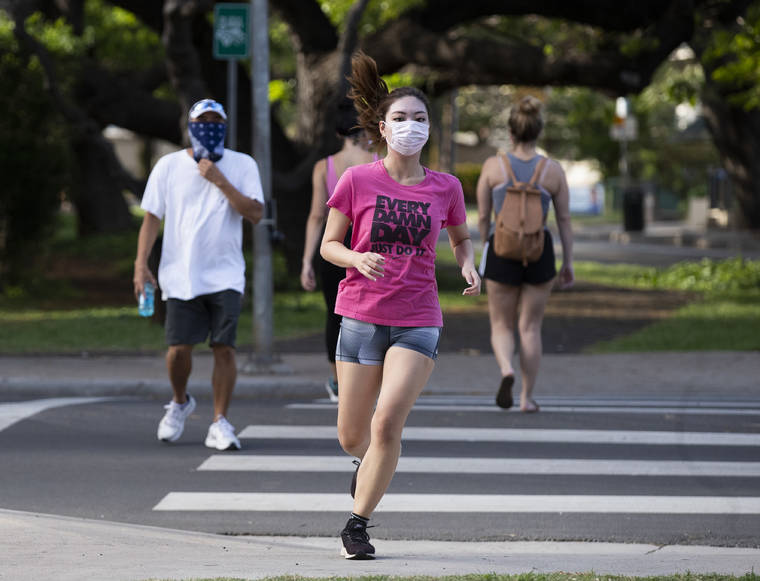A runner can trail respiratory droplets up to 30 feet directly behind, researchers say

CINDY ELLEN RUSSELL / CRUSSELL@STARADVERTISER.COM
A new study says runners can exhale contaminated droplets that can travel up to 30 feet in their wake. People exercised Thursday along Diamond Head Road.

CINDY ELLEN RUSSELL / CRUSSELL@STARADVERTISER.COM
A runner wore a mask as she exercised Thursday at Monsarrat and Paki avenues.


With gyms closed, popular jogging paths from Diamond Head to Kailua Beach are more crowded than ever with walkers and runners.
But compliance with the recommended 6-foot social distancing to prevent the spread of the new coronavirus Opens in a new tab appears uneven, at best.
For instance, going up and down Diamond Head Road or around Kapiolani Park, runners and speedy walkers can be observed overtaking slower pedestrians within a foot or two’s distance and then cutting directly in front of them.
On a recent evening at the juncture of Diamond Head and Beach roads, where the asphalt is uneven and sloping and no painted line separates pedestrians from traffic, a heavy-breathing runner overtook two frail-looking senior pedestrians, brushing past and nearly knocking them down.
Some runners seem oblivious to official social distancing guidelines, despite the crucial role separation plays in keeping the spread of the virus at bay: “Physical distancing, six feet or more, is still the most important mitigation measure when surfing, walking, hiking, riding your bike or doing anything these days,” said Bruce Anderson, head of the state Department of Health, in an email last week.
Now, according to a new study, 6 feet may not be enough distance around runners, joggers, brisk walkers and cyclists, whose exertions release respiratory droplets that can trail in their wake in what the researchers call their “slipstream.”
Don't miss out on what's happening!
Stay in touch with breaking news, as it happens, conveniently in your email inbox. It's FREE!
The researchers found the droplets could travel at least 15 feet behind a fast walker and 30 feet behind a runner.
The study is posted online Opens in a new tab with the unwieldy title “Towards aerodynamically equivalent COVID-19 1.5 m social distancing for walking and running.” It was conducted by physicists in Belgium and the Netherlands and is highly preliminary, having not yet been published in a peer-reviewed journal.
The research was based on a simulation, using a wind tunnel, of how air was displaced by a theoretical exerciser out of doors and how that could affect the range of respiratory droplets, rather than on real-life conditions; the researchers did not examine the behavior of actual coronavirus particles or address infection risks.
But their study aimed to fill an exercise gap, the scientists pointed out, because their current 1.5-meter social distance guidelines, or 6 feet in the United States, are based on how far droplets can travel between people who are standing or sitting still.
Their aerodynamic modeling found that most droplets exhaled by an exerciser were pulled into the wake of air behind the runner or walker and carried aloft for 15 to 30 feet before dissipating and dropping to the ground.
But the good news was that the droplets concentrated in the slipstream directly behind the exerciser, as if trailing from the shoulders like a cape, and so could be avoided simply by stepping to one side if a runner cut in front of you.
By the same token, runners could be more mindful and give a wide berth to people they pass for at least 30 feet, the researchers suggested.
“This suggests that avoiding substantial droplet exposure in the conditions of this study and in a way equivalent to the 1.5 (meters recommended distance) for people standing still can be achieved by one of two actions: either by avoiding to walk or run in the slipstream of the leading person and keeping the 1.5 m distance in staggered or side by side arrangement, or by keeping larger social distances, where the distances increase with the walking or running speed,” the study concluded.
“When overtaking a person, be kind to this person and only when you have reached a certain distance (about 15 feet when walking, 30 feet for running, up to 60 feet for cycling), move back on the same straight line as this person,” said lead author Bert Blocken, a civil engineer and professor at the Department of the Built Environment at Eindhoven University of Technology in the Netherlands, in a useful Q&A Opens in a new tab appended to the study.
The study seemed to add a reasonable consideration for outdoor exercisers, said DOH’s Anderson, who majored in physics as an undergraduate at Colorado College.
“It’s reasonable to assume that a runner’s momentum going forward could, like a breeze, carry droplets and aerosols farther than 6 feet,” Anderson said in a phone interview Thursday.
“But I wouldn’t freak out about someone who’s cut across in front of you and may be positive,” he said, noting that the COVID-19 cases the Health Department has seen to date have resulted from close and sustained exposure.
“The cases we’ve seen so far have involved sustained close exposure to family members or co-workers,” Anderson said. “I have yet to see any evidence of anyone exposed through casual contact.”
People should use their own judgment, he added, and not be afraid to get out and exercise, which is a healthy activity he recommends.
We should also keep in mind, Anderson concluded, that droplets will settle on surfaces behind a runner or walker, lingering there for hours after they’ve passed, so we should be conscientious about washing our hands.



